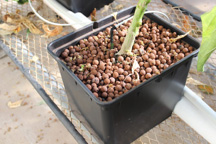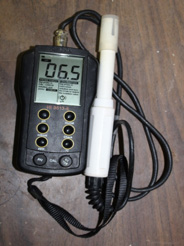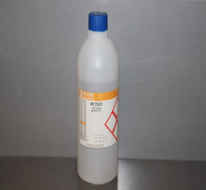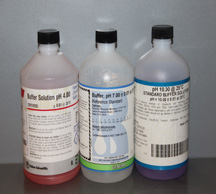Is Ppm Per Feed Or Per Week House And Garden
Electrical Conductivity and pH Guide for Hydroponics
By Hardeep Singh, Bruce Dunn
- Jump To:
- Hydroponics
- Nutrient Management
- Water Analysis
- What is Total Salt Concentration?
- What is pH?
- Alkalinity
- Difference Between Soil and Soilless Culture
- EC Management
- pH Management
- Important Points
- Refreshing the Nutrient Solution
- Automatic Monitoring System
Hydroponics
Hydroponics is a word derived from Greek consisting of two words: 'hydro' meaning water and 'ponos' meaning labor. It is a method of crop production in which plants are grown without soil, and nutrients required for plant growth, are supplied through liquid nutrient solution. Plant roots may or may not be supported by artificial substrate such as perlite, vermiculite, rock wool, expanded clay, coconut coir, wooden fiber or a mixture of substrates like perlite and coconut coir (Figure 1).

Figure 1. Dutch Bucket System with suspended clay balls.
Nutrient Management
Nutrient management is a method of using crop nutrients as efficiently as possible to improve the productivity without harming the environment. In hydroponics, nutrient management is a very necessary step. Total salt concentration, pH, alkalinity and nutrient concentration ratio are four main characteristics to focus on for nutrient management in soilless culture.
Water Analysis
The very first step for hydroponics is to have the water analyzed by a lab such as the Soil, Water and Forage Analytical Laboratory (SWAFL) at Oklahoma State University. Test for pH, electrical conductivity (EC) and alkalinity. Poor-quality water can cause nutrient toxicity or deficiency problems initially or later in production. Water naturally consists of salts like sodium, calcium, magnesium bicarbonates, chlorides and sulfates. These salts can affect EC and pH of the nutrient solution and should not be above the acceptable level (Table 1).
Table 1. Acceptable values for common nutrients found in water.
| Nutrients | Acceptable value (ppm) |
|---|---|
| Sodium | <50 |
| Calcium | <150 |
| Magnesium bicarbonate | <50 |
| Chloride | <140 |
| Sulfate | <100 |
What is Total Salt Concentration?
Nutrients are applied in the form of salts, and when these salts dissolve into water they break down into ions. For example, NaCl breaks down into Na+ and Cl– ions. These ions conduct electricity due to their positive and negative ions. Thus, the conductivity of the solution increases with added ions. So EC is a good measure of amount of salts in the solution. A higher EC means higher salt concentration, while a lower EC means a lower salt concentration.
Excessively high levels of nutrients induce osmotic stress, ion toxicity and nutrient imbalance, while excessively low values are mostly accompanied by nutrient deficiencies and decreasing plant growth. In soilless culture, total salt concentration of a nutrient solution is the most important characteristic. Conductivity Factor (CF) is a measure of the electrical conductivity of a nutrient solution read in mS/cm (millisemen per centimeter) and sometimes given as μs/cm, which can be multiplied by 1,000 to convert to mS/cm.
What is pH?
pH is a measure of how acidic or basic the solution is at the time of reading. The range goes from 0 to 14, with 7 being neutral. The pH of a nutrient solution influences the availability of nutrients, so it should be maintained in the optimum range. Nutrient solutions used for soilless culture should have a pH between 5 to 6 (usually 5.5), so the pH in the root environment is maintained between 6 to 6.5. This is the pH range at which nutrients are most readily available to plants.
Alkalinity
Alkalinity is a term used to express the concentration of bicarbonate (or carbonate, if pH is above 8.2) in 'natural' or uncontaminated waters. Bicarbonate (HCO3-) is alkaline and therefore elevates the pH. High alkalinity water (>75 ppm) will cause the pH to increase in the nutrient solutions. For this reason, it is necessary to check the pH of the nutrient solution more frequently whenever high-alkaline water is used. Alkalinity can be removed by using an acidic fertilizer; adding an acid such as phosphoric acid, citric acid or vinegar; or by reverse osmosis. Reverse osmosis is a process of purifying the water by pushing water using hydrostatic pump through a semipermeable membrane.
Difference Between Soil and Soilless Culture
In soil culture, soil acts as a buffer and helps to maintain a specific pH and EC suitable for plant growth (Table 2). This buffer is absent in soilless culture, so it is important to maintain an environment suitable for plant growth artificially.
Table 2. Optimum range of electrical conductivity (EC) and pH values for hydroponic crops.
| Crops | EC (m $/cm) | pH |
|---|---|---|
| Asparagus | 1.4 to 1.8 | 6.0 to 6.8 |
| African Violet | 1.2 to 1.5 | 6.0 to 7.0 |
| Basil | 1.0 to 1.6 | 5.5 to 6.0 |
| Bean | 2.0 to 4.0 | 6 |
| Banana | 1.8 to 2.2 | 5.5 to 6.5 |
| Broccoli | 2.8 to 3.5 | 6.0 to 6.8 |
| Cabbage | 2.5 to 3.0 | 6.5 to 7.0 |
| Celery | 1.8 to 2.4 | 6.5 |
| Carnation | 2.0 to 3.5 | 6 |
| Courgettes | 1.8 to 2.4 | 6 |
| Cucumber | 1.7 to 2.0 | 5.0 to 5.5 |
| Eggplant | 2.5 to 3.5 | 6 |
| Ficus | 1.6 to 2.4 | 5.5 to 6.0 |
| Leek | 1.4 to 1.8 | 6.5 to 7.0 |
| Lettuce | 1.2 to 1.8 | 6.0 to 7.0 |
| Marrow | 1.8 to 2.4 | 6 |
| Okra | 2.0 to 2.4 | 6.5 |
| Pak Choi | 1.5 to 2.0 | 7 |
| Peppers | 0.8 to 1.8 | 5.5 to 6.0 |
| Parsley | 1.8 to 2.2 | 6.0 to 6.5 |
| Rhubarb | 1.6 to 2.0 | 5.5 to 6.0 |
| Rose | 1.5 to 2.5 | 5.5 to 6.0 |
| Spinach | 1.8 to 2.3 | 6.0 to 7.0 |
| Strawberry | 1.8 to 2.2 | 6 |
| Sage | 1.0 to 1.6 | 5.5 to 6.5 |
| Tomato | 2.0 to 4.0 | 6.0 to 6.5 |
EC Management
The EC of a nutrient solution can be checked by using an EC meter, which can be bought online and ranges from $100 to $500. A meter that has both EC and pH capabilities is also available (Figure 2). The buffer solution, which can be bought online, is used to calibrate the EC meter (Figure 3).

Figure 2. Combination EC and pH meter.

Figure 3. EC buffer solution.
Every buffer solution has a specific EC (usually 1.41 mS/cm). After placing the probe in the buffer solution, set the EC meter to that specific EC by adjusting the knob on the EC meter. This allows you to calibrate an EC meter.
The following steps should be performed for EC management:
- Fill the nutrient tank with tap or filtered water and add fertilizer. Base quantity on the manufacturer recommendation.
- Calibrate the EC meter probe using the buffer solution.
- Make sure the nutrient solution is stirred up and allow the reading to stabilize, which may take a couple of minutes.
- If the reading is higher than the optimum level, dilute the solution by adding more water, then repeat step 3.
- If the reading is below the optimum level, add nutrient concentrate until the optimum level is reached by repeating step 3.
- Rinse the probe in tap water and store in probe-cleaning fluid.
pH Management
The pH of a solution is checked by using a pH meter, which can be bought online and ranges between $100 to $500. A pH meter probe is calibrated using pH buffer solution, which can also be bought online and usually comes in pH 4, 7 or 10 (Figure 4).

Figure 4. pH buffer solutions.
The following steps should be performed for pH management:
- Set the desired EC value of the solution.
- Calibrate the pH meter probe using the buffer solution. Make sure the nutrient solution is stirred up and allow the reading to stabilize, which may take a couple of minutes.
- If the pH reading is high, add phosphoric acid, citric acid, vinegar or pH down products slowly. Wait several minutes before adding more. Repeat until the pH reaches the optimum range.
- If the pH is low, add potassium hydroxide, potassium carbonate or a pH up product slowly. Repeat until the pH reaches the optimum range.
- Clean the probe and store in cleaning fluid.
Important Points
- pH should always be checked after getting the EC into the optimum range.
- The pH and EC should be checked daily.
- Check the pH and EC at the same time of day.
- Water temperature of 72 to 75 F is optimal.
Refreshing the Nutrient Solution
Water may need to be added daily to refresh and replace water consumed by the plants, depending on your water tank size. Nutrient ratios can vary beyond their desired limits through time, causing deficiencies and toxicities. For example, sodium chloride (table salt) will increase in concentration with the constant addition of water and nutrient adjustments, resulting in toxicities. It is advisable to replace the nutrient solution completely every two weeks.
Automatic Monitoring System
The pH and EC can be adjusted manually for small-scale operations, but for commercial farms the amount of solution used in hydroponics is very high, so pH and EC management is time consuming. An automated monitoring system has benefits, such as labor savings, avoiding nutrient shock to plants and removing human error. This system costs between $500 to $4,000. Manufactures that produce products for automatic monitoring systems include Autogrow, Intellidose, Hanna and CropKing Fertroller System to name a few.
Hardeep Singh
Graduate Assistant, Vegetables
Bruce Dunn
Associate Professor, Floriculture
Was this information helpful?
YESNO
Is Ppm Per Feed Or Per Week House And Garden
Source: https://extension.okstate.edu/fact-sheets/electrical-conductivity-and-ph-guide-for-hydroponics.html
Posted by: chapmancorgunts.blogspot.com

0 Response to "Is Ppm Per Feed Or Per Week House And Garden"
Post a Comment